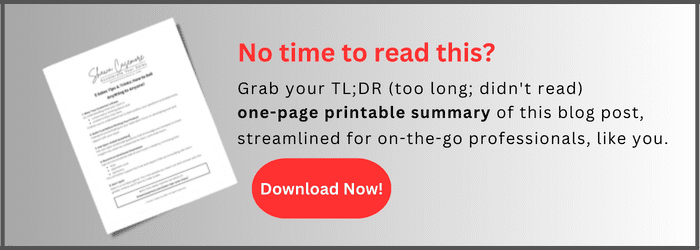Tuesday, November 7, 2023
You’ve closed the sale with one of your more difficult customers and now you’re hearing that sound: “ding ding”.
You’re receiving nonstop emails, maybe even text messages from that brand new customer or client that you just closed and you really haven’t had a chance to let the ink dry on the deal.
Does this sound familiar?
In this post (and video), I’m going to share with you how to deal with difficult customers and strategies that you can take to ensure that a difficult customer is satisfied with the sale.
More importantly, you’ll free up time so you can continue to sell and not get sucked into that “time dump” that often results from sales to challenging customers.
How to Deal With Difficult Customers – Practical Strategies
(0:55)
We’ve all had difficult customers.
Sometimes we recognize they may become difficult customers early on in the sales process. The old saying is that a difficult prospect is oftentimes also a difficult customer or even worse.
Today, I want to walk you through some different strategies that you can apply in order to minimize the time spent with difficult customers while ensuring that they’re still satisfied.

Strategy #1: Let Your Instincts Guide You
(1:19)
Tip number one, be as critical of your prospects as they are of you.
When we’re in sales, a lot of the sales teams and sales professionals that I work with and coach oftentimes tell me they’re just chasing that next sale. And they try to ignore how difficult a prospect might be to work with.
You know the difficult customers I’m talking about:
- overly demanding,
- maybe they have a lot of questions,
- maybe they’re even talking down to you, and
- making you feel bad about yourself during the sales process.
Those prospects oftentimes do become very difficult or challenging customers to deal with, but not all of them do.
We want to make sure that during the prospecting process, we’re checking in with our prospects to make sure they’re a good fit.

I like to use language such as
- “I’ve got a few questions for you before we move forward because I want to make sure this is a good fit for both of us.” or,
- “Our product is not for everybody, so if I could just ask you a few questions, I want to make sure this is the best fit for you.”
What you’re really doing in using those questions is setting up a bit of an interview and then you can resort to asking the kind of questions that will identify to you whether this going to be a challenging customer or not?
- What are their expectations on response time? How quickly do they expect you to respond?
- If they have questions, do they expect to have questions during the process?
- Who’s going to be leading when you sign the deal?
- Who will be your single point of contact as you move forward?
If we flesh this out early by asking those questions I posed, we’re able to be critical of prospects and for those that might not be a good fit, that might turn into a really challenging customer and be almost impossible for us to satisfy.
We can make a decision then if we really want to move forward with this prospect or not.
Strategy #2: Judge Your Prospect As They Judge You
(3:10)
Building on point number one, you want to have several questions at the ready that really allow you to understand if this will be a difficult customer.
Now depending on what you’re selling, the market that you’re in, so whether you’re selling a product or service, whether you’re selling something that’s more commodity or specialized, the questions will vary.
What I’d really like you to do is think about a really good customer that you’ve worked with in the past and identify the characteristics of traits.

What was the experience like with that customer? Describe it, identify it, and write down some key points.
- Maybe that customer was somebody who was easy to get ahold of, and
- maybe they were only reaching out to you every few weeks with questions rather than every day, and
- maybe they gave you time to respond.
Describe the attributes or characteristics of that really good customer that you’ve had. Now, identify the opposite of those.
So what I should do is write these attributes down on a piece of paper and put “good” at the top and then simply put an arrow over and write “bad” at the top of that list and simply write the opposite.
For example, if you say that they were patient, then obviously a bad or challenging customer is one that is impatient. If you say that there was a single point of contact, then a challenging customer might be somebody where there are multiple points of contact.
As you write down the opposite, what you’re really doing is creating a list of the characteristics or again, attributes of a challenging customer when you do this. Now you can use this column, this bad column if you will, or maybe it’s better to call it a challenging customer column.
You can use this as part of your questions.
So you can say, “A question for you: Who will be the single point of contact on this project or in this sale?” If they say, “Well, there’s six of us, we’ve all got different priorities, we’re going to be contacting you constantly.” That’s maybe a sign that, okay, they’re falling in the bad category. It allows you to create a checklist so that you can determine early on if this going to be a good fit or not.
Remember, in sales, our goal is to sell, although we have to be good at managing accounts because oftentimes there’s an opportunity to sell more within an existing account. We don’t want to spend all of our time there and if we take on too many challenging clients, that’s what we’ll end up doing and we won’t have any capacity left to make a new sale.
Make sure you make those two lists and then create questions around that challenging customer column that we identified so that you can flesh out whether this is a good fit for them and for you.
Strategy #3: Don’t Overcommit
(5:40)
Number three: Do not (I repeat)… Do not overcommit.
Let’s be honest, when we’re in sales, we’re selling and we get on a roll, customers start to ask questions.
It’s easy for us to say,
- oh yeah, we’ll take care of that.
- Well, that won’t be a problem,
- That shouldn’t be an issue at all.
- I’ll take that back, but I don’t see that stopping us from moving forward.
Indirectly, we overcommit.

Now, some customers are okay with that. You say, “Well, lemme get back to you, but I think that’ll be fine.” And if you have to get back to ’em and say, that’s not going to work, some customers are okay with that.
But other customers, right? The challenging ones, they’re taking notes:
- “Sean said he’d do this.
- Sean said this was okay.
- Sean was going to stand and walk on his hands, and
- Sean was going to tell us all these things.”
Well, let’s be honest. If I can’t meet those obligations and this is a challenging prospect, it’s going to be a problem once I close them, right?
What you want to be doing is paraphrasing at the end of your discussions with each customer, (especially those that you deem that might be a challenging prospect here), paraphrase what the next steps look like and what you’re committing to.
That allows an opportunity for them to say, oh, but you missed this. At that point, you can re-clarify. “You raised a good point. I am going to look into that, but at this point, I can’t make a commitment.”
If you paraphrase at the end of your discussions with your prospect, especially if they’re a challenging one, it’s very important. What you do is you flesh out the expectations for them as well as for yourself. And if anything is missing, it’s the opportunity to bring it forward and it really protects you later on.
If they’re making a demand that was never committed to, you can say, “Well, hold on a second, I don’t recall us discussing this”. And they can say, “Well, you mentioned it in the meeting.” And you can say, “Well, at the end of the meeting I always paraphrase, I don’t recall bringing that up.”
Okay, so it kind of protects you and sets you up for success and allows you to flesh out these challenging customers and make sure that their expectations are really aligned around what they’re going to receive once you ink the deal.
Strategy #4: Communicate Next Steps
(8:00)
Number four: Be proactive about communication.
As soon as you ink that deal, as soon as they sign, (or send back that PO, whatever your process is), be proactive about your communications.

I often suggest to sales professionals that I work with to set up some automation, right? You can use different CRM systems like
HubSpot or
Salesforce. There are all sorts of different variations.
You can set up automated emails that happen to be sent once you do certain things within CRM.
So you might say, once I click this button, boom, this email gets sent. It’s a welcome email. It tells my new customer what to expect next. In my experience, what often happens is prospects that aren’t that challenging quickly become challenging when they’re really not sure what the process looks like.
So you show up, you ink the deal, you move on to the next one, they hear nothing maybe for a day, maybe for a week, maybe for a month, maybe for a year, and then suddenly they start to get impatient. By the time they reach out, they’re a challenging customer because they’re not happy.
You can set up proactive communication, which you can even automate using your CRM if you have one. If you don’t have one, create templates.
Put it in your calendar to remind yourself to send these on certain times and days following making the deal.
This way, you’re keeping this new customer in the loop, which means there’s less of a chance that they’ll become challenging and upset. With more of a chance that you’ll be keeping them up to speed on what’s to happen next. This frees up your time dealing with last-minute questions.
Strategy #5: Re-Educate Your Customer
(9:33)
If you’ve done everything we’ve talked about so far and your customers are still all over you, and they’re being challenging because they’re making a lot of demands of you and your time, don’t be afraid to reorient them around what the process is. This allows them and you to move forward.
We don’t want to lose a sale.
And oftentimes there are a lot of things we can do proactively that reduce the amount of challenging customers that we sign up, and it really reduces any stress those customers carry, which means they’re less of a challenge to deal with.
But if you’ve done these things and it is not working, you need to reach back out to the customer, set up a call, set up a meeting, say, look, we should go back through what these next steps are, what we committed to you, and just make sure we’re all on the same page.

Don’t be scared to do this. If you lose the sale, you lose the sale. I know you don’t want to hear that, but it is better that we walk away from something that is creating more agony for us and our organization than to continue to try and move it forward. I can almost guarantee you it’s only going to get worse.
Okay? So this is the last ditched effort to salvage the sale, to set clear expectations, and to make sure you’re clear on what that new customer is looking for so you can satisfy it and be able to move forward.
Your Next Steps: Learning How to Deal With Difficult Customers
(10:45)
If you want to be successful in sales and really stay on top of managing difficult customers from
- setting up automation, to
- proactively communicating with new customers, to
- making sure you’re sticking with your prospecting activities to bring new customers into your pipeline,
you need a tool, a method to stay on track. That’s why I created what I call the 30-Day Sales Action Planner.
It’s a simple document you can use. It walks you through all the steps that you need to follow day-by-day, week-by-week. Ultimately we’ll allow you within 30 days to put yourself on track to the best year you’ve ever had.
So, grab your copy by clicking the link above. It’s free. There’s no obligation, and you can put it to work and use it in PDF form, you can print it off however you prefer. Make sure you click the link and grab your copy today.
One of the ways in which you can deal with challenging customers is to work on your influence. It’s to be more influential. What that allows you to do is early on, calm that challenging customer down, make sure they’re clear on what’s going to happen and they’re feeling good about those next steps.
Until next time, let’s get out there and go sell something.

© Shawn Casemore 2023. All Rights Reserved.